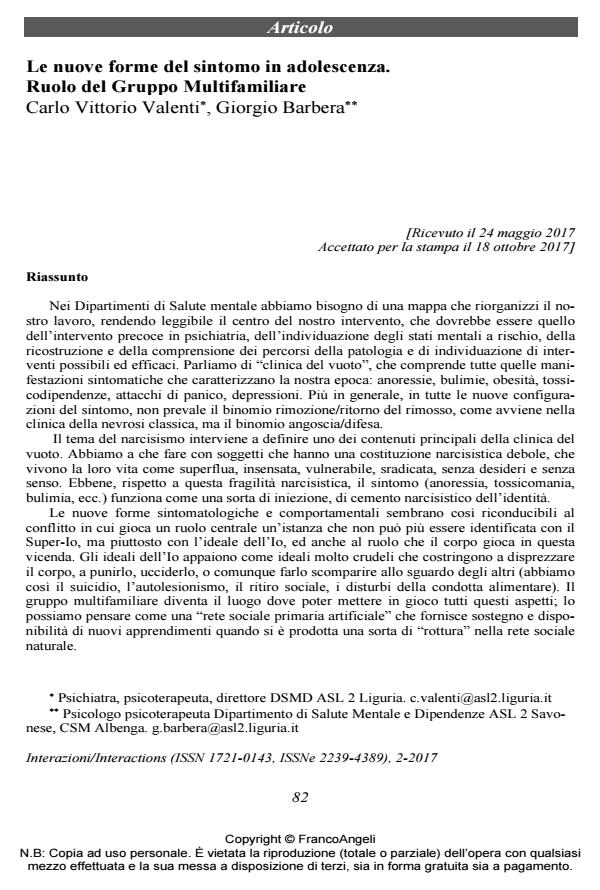The new forms of symptom in adolescence. Role of the multifamily group.
Journal title INTERAZIONI
Author/s Carlo Vittorio Valenti, Giorgio Barbera
Publishing Year 2017 Issue 2017/2
Language Italian Pages 14 P. 82-95 File size 183 KB
DOI 10.3280/INT2017-002008
DOI is like a bar code for intellectual property: to have more infomation
click here
Below, you can see the article first page
If you want to buy this article in PDF format, you can do it, following the instructions to buy download credits

FrancoAngeli is member of Publishers International Linking Association, Inc (PILA), a not-for-profit association which run the CrossRef service enabling links to and from online scholarly content.
In Mental Health Departments we need a map to organize our work, which should be that of early intervention in psychiatry, the identification of mental states at risk, reconstruction and understanding of pathology and identification of possible and effective interventions. We talk of "vacuum clinic", which includes all those symptomatic manifestations that characterize our age: anorexia, bulimia, obesity, drug addiction, panic attacks, depressions. More generally, in all new symptom configurations, the "removal/return of removal" binomial does not prevail, as is the case in classical neuroscience, but the "distress/defense" binomial. The theme of narcissism plays a main role to define one of the main contents of the vacuum clinic. We are dealing with subjects who have a weak narcissistic constitution, who live their lives as superfluous, senseless, vulnerable, uprooted, unwitting and meaningless. Well, with respect to this narcissistic fragility, the symptom (anorexia, addiction, bulimia, ecc.) works like a kind of narcissistic cement of identity. The new symptomatic and behavioral forms seem to be related to the conflict in which a central role plays an instance that can no longer be identified with the superego but rather with the ideal of the ego, and also with the role the body plays. The ideals of ego appear to be very cruel ideals that force you to despise your body, to punish it, kill it, or otherwise make it disappear to the eyes of others (we have suicide, selfishness, social retreat, eating disorders). The multifamily group becomes the place where it’s possible to work over these problems; we can think at the group as a "primary social network" that provides support and availability of new learning when it has produced a sort of "break" in the natural social network.
Keywords: Early intervention, mental states at risk, vacuum clinic, narcissism, multi-family group.
Carlo Vittorio Valenti, Giorgio Barbera, Le nuove forme del sintomo in adolescenza. Ruolo del Gruppo Multifamiliare in "INTERAZIONI" 2/2017, pp 82-95, DOI: 10.3280/INT2017-002008